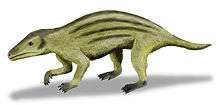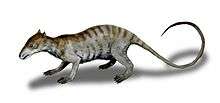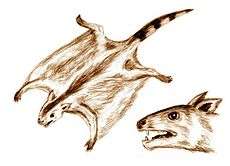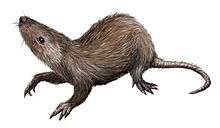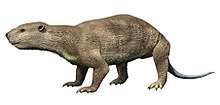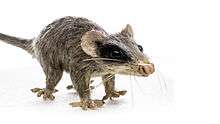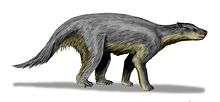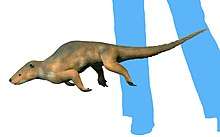Mesodma
Mesodma is an extinct genus of mammal, a member of the extinct order Multituberculata within the suborder Cimolodonta, family Neoplagiaulacidae. It lived during the upper Cretaceous and Paleocene Periods of what is now North America.
| Mesodma | |
|---|---|
| Scientific classification | |
| Kingdom: | Animalia |
| Phylum: | Chordata |
| Class: | Mammalia |
| Order: | †Multituberculata |
| Family: | †Neoplagiaulacidae |
| Genus: | †Mesodma |
| Species | |
| |
Species
- Mesodma ambigua
- Place: Mantua Lentil, Wyoming (USA)
- Age: Maastrichtian-Puercan, Upper Cretaceous - Paleocene
- Weight: about 55 g
- Mesodma formosa
- Place: Hell Creek and Frenchman Formation, USA & Canada. This species is possibly also known from Utah.
- Age: Maastrichtian-Puercan (Upper Cretaceous to the Paleocene).
- Weight: about 30 g
- Mesodma hensleighi
- Place: Hell Creek Formation in the U.S. and in Saskatchewan, Canada.
- Age: Campanian (Upper Cretaceous).
- Weight: around 15 g
- Mesodma primaeva
- Place: Montana and Wyoming
- Age: Campanian (Upper Cretaceous – Lower Paleocene)
- Mesodma pygmaea
- Place: Gidley Quarry, Montana, as well as Wyoming and Alberta, Canada
- Age: Torrejonian-Tiffanian (Middle Paleocene).
- Weight: about 8 g
- Mesodma senecta
- Age: Campanian (Upper Cretaceous)
- Weight: about 50 g
- Mesodma thompsoni (=M. garfieldensis)[1]
- Place: St Mary River Formation & Montana and Wyoming of the USA and Canada
- Age: Maastrichtian-Puercan, Upper Cretaceous - Paleocene
- Weight: about 55 g
References
- Smith, Stephanie M.; Wilson, Gregory P. (2016). "Species Discrimination of Co-Occurring Small Fossil Mammals: A Case Study of the Cretaceous-Paleogene Multituberculate Genus Mesodma". Journal of Mammalian Evolution. doi:10.1007/s10914-016-9332-2.
- Osborn (1891); "A review of the Cretaceous Mammalia". Proc. Acad. Nat. Sci. Phila. 124 - 135.
- Simpson (1929), "American Mesozoic Mammalia". Mem. Peabody Mus. Nat. Hist. iii (i): p. 1-235.
- Clemens (1963), "Fossil mammals of the type Lance formation Wyoming. Part I. Introduction and Multituberculata". Univ. Calif. Pub;. Geol. Sci. 48, p. 1-105. (According to Peabody Museum database.)
- Marsh (1889), "Discovery of Cretaceous Mammalia". Am. J. Sci. (3) xxxviii, p. 177-180.
- Archibald (1982), A study of Mammalia and geology across the Cretaceous-Tertiary boundary in Garfield County, Montana. Univ. of Calif. Publ. Geol. Sci. 122xvi+, 286pp.
- Jepsen (1940), "Paleocene faunas of the Polecat Bench formation, Park County, Wyoming". Pro. Amer. Philos. Soc 83, p. 217-341, 21 figs., 5 pls.
- Kielan-Jaworowska, Z; Hurum, JH (2001). "Phylogeny and Systematics of multituberculate mammals". Palaeontology. 44: 389–429. doi:10.1111/1475-4983.00185.
This article is issued from Wikipedia. The text is licensed under Creative Commons - Attribution - Sharealike. Additional terms may apply for the media files.

